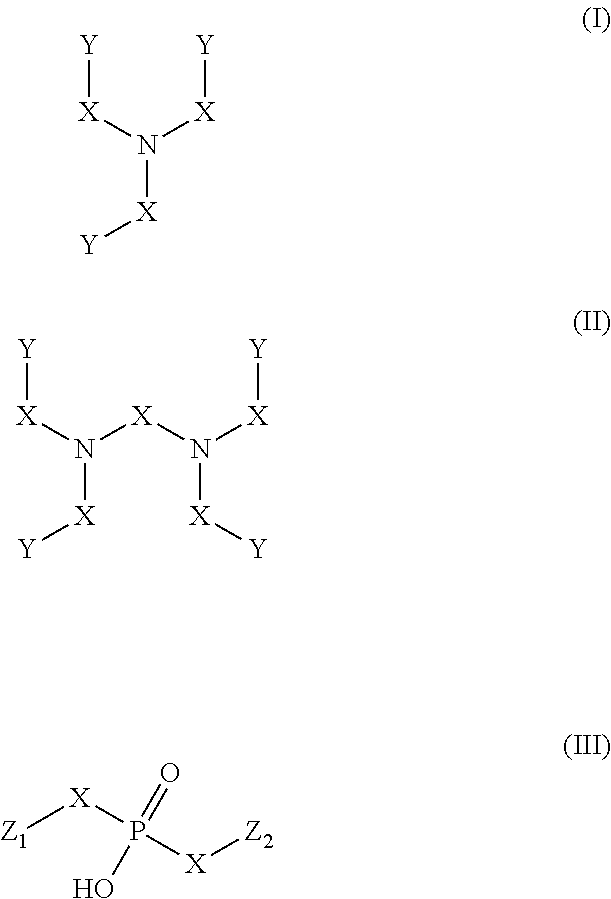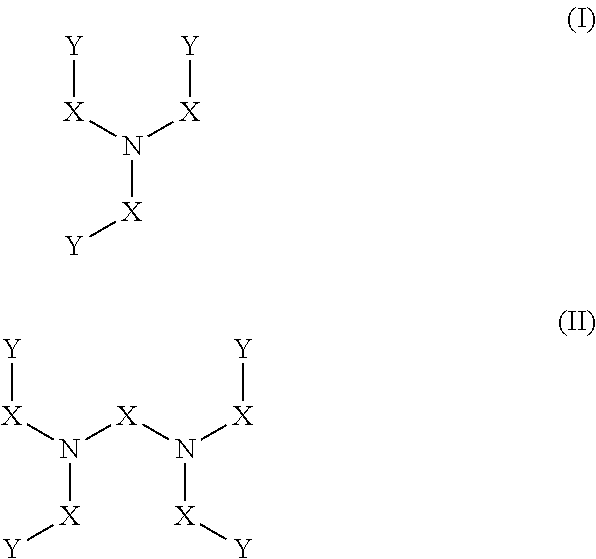Compositions and methods for resisting discoloration of wood and treated wood
a technology of discoloration and composition, applied in the field of compositions and methods for resisting discoloration of wood and treated wood, can solve the problems of ineffective physical and chemical remediation techniques of wood in negating, correcting and/or resisting unwanted discoloration of wood, and the negative influence of capital investment in equipment needed on the economics of these methods, so as to resist undesired discoloration of wood and reduce unwanted discoloration in wood
- Summary
- Abstract
- Description
- Claims
- Application Information
AI Technical Summary
Benefits of technology
Problems solved by technology
Method used
Image
Examples
example 1
[0073]A wood preservative solution containing 1062.0 grams of a borate buffered, aqueous amine-oxide containing wood preservative solution was heated to 60° C. (±2° C.) and stirred until homogeneous. 21.21 grams of nitrilotriacetic acid was added and the solution was allowed to stir at 60° C. (±2° C.) until homogeneous. Sugar Pine lumber, of the dimensions approximately 20 mm deep, 140 mm wide and 128 mm long was immersed for 1 second in the hot wood preservative solution. The samples were then placed in a suitable plastic covering for 12-24 h at 40° C. (±2° C.) before unwrapping and drying the samples for 1-2 h at room temperature and humidity. Standard commodity white primer was applied to approximately one-half of the surface area of the sample to 3-5 wet mils thickness by brush application over two coats with approximately 45 min dry time between applications of the second coat. The samples were dried for a minimum of 12 h at ambient temperature and humidity. The samples were th...
example 2
[0075]A wood preservative containing 886.0 grams of a borate buffered, aqueous amine-oxide containing wood preservative solution was heated to 60° C. (±2° C.). The solutions were heated to 60° C. (±2° C.) and stirred until homogeneous. 8.97 grams of 1-hydroxyethylidene-1, 1-diphosphonic acid was added and the solution was allowed to stir at 60° C. (±2° C.) until homogeneous. Sugar Pine lumber, of the dimensions approximately 20 mm deep, 140 mm wide and 128 mm long was immersed for 1 second in the hot wood preservative system. The samples were then placed in a suitable plastic covering for 12-24 h at 40° C. (±2° C.) before unwrapping and drying the samples for 1-2 h at room temperature and humidity. Standard commodity white primer was applied to approximately one-half of the surface area of the sample to 3-5 wet mils thickness by brush application over two coats with approximately 45 min dry time between applications of the second coat. The samples were dried for a minimum of 12 h at...
example 3
[0076]827.3 grams of a borate buffered, aqueous amine-oxide containing wood preservative solution was heated to 60° C. (±2° C.). The solutions were heated to 60° C. (±2° C.) and stirred until homogeneous. 16.60 grams of nitrilotriacetic acid and 8.58 grams of 1-hydroxyethylidene-1,1-diphosphonic acid was added and the solution was allowed to stir at 60° C. (±2° C.) until homogeneous. Sugar Pine lumber, of the dimensions approximately 20 mm deep, 140 mm wide and 128 mm long was immersed for 1 second in the hot wood preservative system. The samples were then placed in a suitable plastic covering for 12-24 h at 40° C. (±2° C.) before unwrapping and drying the samples for 1-2 h at room temperature and humidity. Standard commodity white primer was applied to approximately one-half of the surface area of the 20 mm deep, 140 mm wide and 128 mm long sample to 3-5 wet mils thickness by brush application over two coats with approximately 45 min dry time between applications of the second coat...
PUM
| Property | Measurement | Unit |
|---|---|---|
| Temperature | aaaaa | aaaaa |
| Temperature | aaaaa | aaaaa |
| Temperature | aaaaa | aaaaa |
Abstract
Description
Claims
Application Information
 Login to View More
Login to View More - R&D
- Intellectual Property
- Life Sciences
- Materials
- Tech Scout
- Unparalleled Data Quality
- Higher Quality Content
- 60% Fewer Hallucinations
Browse by: Latest US Patents, China's latest patents, Technical Efficacy Thesaurus, Application Domain, Technology Topic, Popular Technical Reports.
© 2025 PatSnap. All rights reserved.Legal|Privacy policy|Modern Slavery Act Transparency Statement|Sitemap|About US| Contact US: help@patsnap.com



